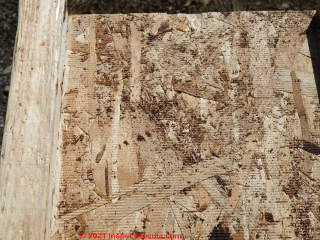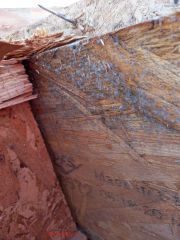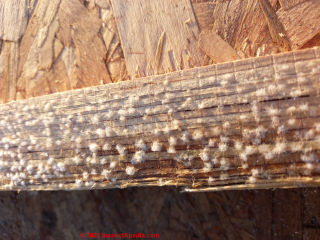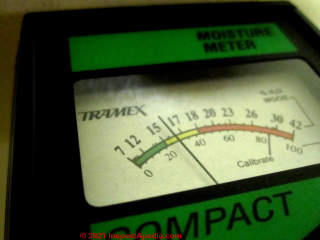 Mold on Wood I-Joists & Trusses
Mold on Wood I-Joists & Trusses
Appearance of Mold on Framing Lumber
- POST a QUESTION or COMMENT about what mold looks & how to remove it from engineered wood, I-Joists & Trusses
Photographs of mold growth in buildings:
Here we discuss and illustrate mold growth on and contamination of engineered wood, framing lumber, I-joists and Trusses.
InspectAPedia tolerates no conflicts of interest. We have no relationship with advertisers, products, or services discussed at this website.
- Daniel Friedman, Publisher/Editor/Author - See WHO ARE WE?
Mold Contamination of Wood I-Joists & Trusses
 Because heat and pressure are involved in the manufacture of engineered wood, I-joists, LVL, web-trusses and other wood truss material and because manufacturers would not be expected to start production with wet wood, it can be a surprise to find mold growth on these structural members.
Because heat and pressure are involved in the manufacture of engineered wood, I-joists, LVL, web-trusses and other wood truss material and because manufacturers would not be expected to start production with wet wood, it can be a surprise to find mold growth on these structural members.
But mold growth does show up on engineered wood, joists, and trusses both before and after their use in construction.
Above: harmless cosmetic dark brown or black mold found on the OSB web of a wood I-Truss at a construction project we worked in 2011.
Watch out: usually we think we can be sure that cosmetic mold was brought in on framing lumber by noticing that its growth pattern does not extend on to other abutting or touching wood surfaces.
But that is not always true. In particular if the abutting or touching wood surfaces are a different wood species or were manufaactured using a different process we may find mold growth on one surface but not on another that it touches.
An excellent example of this problem is explored in this article where our reader's photos show white mold on just the engineered truss top and bottom chords of wood I-joists that use a center web of OSB.
The particular mold genera/species and mold color and location found on engineered wood products like web trusses and engineered wood framing products will vary and may be affected by the chemistry of the glues or adhesives used in producing engineered wood joists and trusses as well as depending on the conditions of joist or truss transportation and storage or conditions in the building where these framing members have been installed.
Except for the dark cosmetic mold described
you can not assume that other mold growth on wood used inside buildings is harmless.
Question: We plan to use ozone and hydrogen peroxide on these moldy I-joists: is that a good remediation plan?
 Thank you for your extensive information and articles about mold remidiation. My husband has a mold intolerance so we moved from our last home and decided to build a home.
Thank you for your extensive information and articles about mold remidiation. My husband has a mold intolerance so we moved from our last home and decided to build a home.
After delays in the building process we ended up exactly where we didn't want to be... building during Winter.
Thankfully it has been a mild Winter but we do have white fluffy mold starting on the floor joists in the crawl space.
I am contacting you with my plan for remediation hoping you can confirm with me that this should work... and what to do to seal the wood.
First, I have an industial ozone generator that I plan to use in the crawl space the day before.
I will let it run 4-6 hours. I plan to use a 6% hydrogen peroxide solution with a wire brush and disposable rags to clean the mold and then will run the ozone generator again while the surfaces dry. After the surfaces are clean and dry I plan to use a mold sealer or paint.
The Foster sealant looks like the best option but is pretty expensive. Do you think I could get away with using a Kilz paint type product since I am doing so much on the cleaning and sanitizing end?
After remidiation I will be getting a dehumidifier. I plan to use the ozone generator and inspect regularly for any new growth.
Please advise on the sealer/paint option. - Anonymous by private email 2021/01/25
Moderator reply: Not the best
No, sorry, but I have no confidence whatsoever that your plan will work successfully, and
 Watch out: you risk making problems worse if you overdose with ozone.
Watch out: you risk making problems worse if you overdose with ozone.
See details at OZONE MOLD / ODOR TREATMENT WARNINGS
And "killing" mold doesn't work: leaving toxic but "dead" particles
See more at MOLD KILLING GUIDE
Sealants are never a substiture for the proper approach:
- remove the mold
- clean the exposed surfaces
- find and fix the reason the mold grew in the first place
See details about sealants
at FUNGICIDAL SEALANT USE GUIDE
See and read the following three articles, and then ask me further as needed:
MOLD CLEANUP GUIDE- HOW TO GET RID OF MOLD - home
MOLD CLEANUP - MISTAKES to AVOID
If it is justified, what's useful is a thorough inspection by an expert.
First see MOLD / ENVIRONMENTAL EXPERT, HIRE ? for help in deciding if it's appropriate to bring in an expert.
If people are sick and you suspect a building-related cause or if you already know that there is extensive mold contamination in the building then You need an on-site inspector who can examine the building, give you a written, photo-documented, authoritative report of what hazards exist, where they are, and what cleaning is needed.
A thorough visual inspection of the building exterior and interior for visible mold contamination, building leak history, areas of high moisture, prior leaks, sewer backups, etc., combined with occupant interviews, an understanding of the building's age, materials of construction, history, geographic location and other factors all of which permit a useful description of
- the extent of mold or other hazards present
- the identification of areas where further invasive or destructive inspection is warranted
- the required work to remove the mold
- the required work to fix the mold's cause
 It's best if that work is performed by someone who has no business nor financial relationship with the company who will do the mold remediation work - avoiding a conflict of interest and any taint ofhaving profited from the work performed protects everyone involved.
It's best if that work is performed by someone who has no business nor financial relationship with the company who will do the mold remediation work - avoiding a conflict of interest and any taint ofhaving profited from the work performed protects everyone involved.
If your mold expert simply stopped by, performed a mold test or two, and tossed the test results over the wall to you, that wasn't very helpful. If I had done that when I worked as an environmental inspector I'd have expected my client to as for her money back.
This article ACTION GUIDE - WHAT TO DO ABOUT INDOOR MOLD offers an organized approach to building mold concerns. It provides links to detailed articles on each phase of concern with, testing for, test validity, cleaning up of, and prevention of future mold problems in buildings.
Please take a look there and don't hesitate to ask follow-up questions.
See also
Reader follow-up: Our GC does mold remediation. He said.. "the white fluffy stuff is no big deal" "harmless" and "easy to remediate"
Thank you for your quick response! I DO plan clean and remove the mold from the TJIs (the only place it's growing mind you) ((I am convinced that this is a problem with the TJI material itself -which is a real hot button for me!)) I will read the articles that you sent and will contact you with further questions.
I Wanted to attach pictures of the mold.
Our GC does mold remediation. He said.. "the white fluffy stuff is no big deal" "harmless" and "easy to remediate" - not the answer wanted which is why I set out to handle it myself.
[Photos above - Ed.]
Moderator reply: your contractor is only partly-right
Well I agree with your GC in part:
- the total quantity of contiguous mold is probably less than 30 sq.ft. of contiguous mold, so doesn't merit a professional mold remediator.
But the GC cannot possibly say that the mold is "harmless" without having done a test to determine the mold genera and species;
Plenty of white molds are allergenic, pathogenic, or even toxic, and two contractors I've worked with each permanently lost an eye to mold infection that they got when fooling with moldy material like that in your photos. So don't get mold on your finger and then put it in your eye nor into other sensitive areas.
The presence of mold growth along the glue-lam chord of your wood I-trusses is interesting and not a surprise. Different genera/species of mold like different conditions and foods; I suspect that there may be something in the glue or wood of the moldy I-truss chords in your photos that was attractive, combined of course with storage of the joists in an environment where mold-growth conditions were sufficiently inviting, such as moisture.
Reader reply: we like media blasting to clean wood I-joists
I hope that we are able to get it resolved and maybe help someone else.
Just FYI and to be fully transparent.. These I joists were left in the rain and snow for about 3 weeks. After they were installed it rained again on the deck and there was standing water on the vapor barrier in the crawl space for about 2 weeks before I noticed. Since then we have vacuumed the water and put large fans in the crawl space to keep air circulating until the home is dried in - hopefully by the end of this week.
Unfortunately, it is supposed to rain/snow this week so the crawl space will be full of water again. Therefore we have to wait for the house to be dried in before we can begin remediation.
After reading the material that you sent, I am pretty well sold on the media blasting.. never heard of it before and so thankful to hear about it now. Luckily it, appears that we have some local companies that do both the dry ice and the soda blasting so I plan to contact them for price comparisons.
Although, the area affected may not be large enough to warrant professional remediation, I would feel more confident having it done due to my husband's mold illness. I truly thought this was going to be an on going battle forever but the media blasting gives me hope that the battle CAN be won! 🤞🏻🤞🏻So glad I found your website! Would love to get your thoughts on the ERMI test as well.
Thanks again for everything.
Moderator reply: media blasting is best for very irregular surfaces or where cosmetic appearnce of wood is important
Media blasting, IMO, is very effective when the cosmetic appearance of wood is important - media blasting is also best and most useful when having to clean irregular surfaces where otherwise the labor cost would be high.
but
otherwise may not be cost-justifed; if you clean off surface mold you can leave the stained wood - it'll be harmless, provided you also find and fix the cause of mold growth
or
if you prefer you can clean and then apply a fungicidal sealant - as added "insurance" against moisture uptake.
If your building is sealed against the weather and thus has reached "dry-in" status then I'd clean the surfaces - simple scrubbing with any household cleaner would be ok - let them dry, and seal them up; I presume we're looking at I-joists that will either be left exposed in a basement or crawl area or that will later be covered by a ceiling; in that case you don't need to do the very thorough (and beautiful) media blasting that Dennis and I wrote about and documented.
The approach I describe ought to save you considerable money.
Details are at WOOD FRAMING & PLYWOOD MOLD CLEANUP
Reader follow-up: moldy I-joists were exposed to wet conditions
These I joists were left in the rain and snow for about 3 weeks. After they were installed it rained again on the deck and caused standing water on the vapor barrier in the crawl space for about 2 weeks before I noticed. - I believe it was a combination of all of the above. However, I feel that there HAS to be something in the make up of the top and bottom chords of the I -joists that caused those areas specifically to sprout the mold.
I've decided to go with your suggestion to clean off the joists with soapy water. Although we aren't dried in, do you think it is worth the trouble to wipe them now? Or should I just wait until I know it will be dry. It's making me crazy knowing it's there and not getting rid of it.
Moderator reply: When to clean moldy wood framing lumber during construction; dry-in is key
 Agreed; I thought I mentioned the glue and wood species of the engineered wood I-truss chords earlier, if not, those are probably the determinants;
Agreed; I thought I mentioned the glue and wood species of the engineered wood I-truss chords earlier, if not, those are probably the determinants;
You could clean now but if the trusses are not protected from the weather and water or even from high humidity then mold growth is likely to return;
IF you could clean now
AND get the surfaces very dry (18% or less moisture using a wood moisture meter)
THEN you could improve the mold resistance by adding a fungicidal sealant coating - that also resists moisture uptake in the wood.
Details are at: MOISTURE METER STUDY
The downside of waiting until dry-in is leaving a hazard for workers and a larger mold inoculation source that *might* increase the risk of other surfaces getting moldy.
Usually I argue the opposite; all mold is everywhere all the time; what makes it grow on a surface are local conditions of moisture and temperature and thus, opportunity.
Because I'm a compulsive sort, if it were my building I'd probably clean now and clean again after dry-in. And I'd keep an eye on other surfaces and I'd do whatever possible to keep out accumulated water pending dry-in.
For example, if a building has reached "dry-in" status (roof sealed, walls, windows in, etc., but there is standing water in a basement or crawl area then that area must be dried out or we're begging for mold growth on other building surfaces.
And in my opinion it's a mistake to let a builder ignore mold by installing insulation or drywall over it, as that now-hidden mold reservoir may only increase and can ultimately affect building occupants, leading to a far more-costly demolition and cleanup job later.
...
Continue reading at MOLD on FRAMING LUMBER, Joists, Studs, I-Joists, or select a topic from the closely-related articles below, or see the complete ARTICLE INDEX.
Or see these
Recommended Articles
- ACTION GUIDE - WHAT TO DO ABOUT INDOOR MOLD
- BLACK MOLD, HARMLESS
- MOLD APPEARANCE on VARIOUS SURFACES index to photos of mold on all kinds of surfaces and materials
- MOLD APPEARANCE - WHAT MOLD LOOKS LIKE - home
- MOLD APPEARANCE - STUFF THAT IS NOT MOLD
- MOLD in BUILDINGS
- MOLD CONTAMINATION IN BUILDINGS - home
- WOOD FRAMING & PLYWOOD MOLD CLEANUP
Suggested citation for this web page
WOOD I-JOIST & TRUSS MOLD CONTAMINATION at InspectApedia.com - online encyclopedia of building & environmental inspection, testing, diagnosis, repair, & problem prevention advice.
Or see this
INDEX to RELATED ARTICLES: ARTICLE INDEX to MOLD CONTAMINATION & REMEDIATION
Or use the SEARCH BOX found below to Ask a Question or Search InspectApedia
Ask a Question or Search InspectApedia
Try the search box just below, or if you prefer, post a question or comment in the Comments box below and we will respond promptly.
Search the InspectApedia website
Note: appearance of your Comment below may be delayed: if your comment contains an image, photograph, web link, or text that looks to the software as if it might be a web link, your posting will appear after it has been approved by a moderator. Apologies for the delay.
Only one image can be added per comment but you can post as many comments, and therefore images, as you like.
You will not receive a notification when a response to your question has been posted.
Please bookmark this page to make it easy for you to check back for our response.
IF above you see "Comment Form is loading comments..." then COMMENT BOX - countable.ca / bawkbox.com IS NOT WORKING.
In any case you are welcome to send an email directly to us at InspectApedia.com at editor@inspectApedia.com
We'll reply to you directly. Please help us help you by noting, in your email, the URL of the InspectApedia page where you wanted to comment.
Citations & References
In addition to any citations in the article above, a full list is available on request.
- In addition to citations & references found in this article, see the research citations given at the end of the related articles found at our suggested
CONTINUE READING or RECOMMENDED ARTICLES.
- Carson, Dunlop & Associates Ltd., 120 Carlton Street Suite 407, Toronto ON M5A 4K2. Tel: (416) 964-9415 1-800-268-7070 Email: info@carsondunlop.com. Alan Carson is a past president of ASHI, the American Society of Home Inspectors.
Thanks to Alan Carson and Bob Dunlop, for permission for InspectAPedia to use text excerpts from The HOME REFERENCE BOOK - the Encyclopedia of Homes and to use illustrations from The ILLUSTRATED HOME .
Carson Dunlop Associates provides extensive home inspection education and report writing material. In gratitude we provide links to tsome Carson Dunlop Associates products and services.

